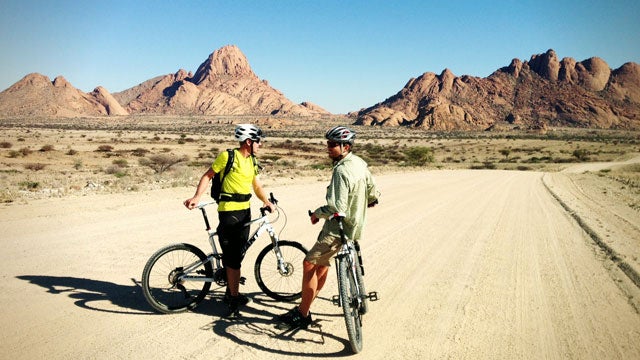It’s amazing, the people you meet in Namibia’s bush—especially while you’re mountain-biking.
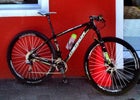 An XTR-equipped carbon Merida full-suspension bike that Heymans once raced in the Cape Epic
An XTR-equipped carbon Merida full-suspension bike that Heymans once raced in the Cape Epic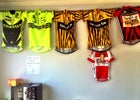 A few of Mr. Africa’s winning jerseys.
A few of Mr. Africa’s winning jerseys.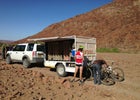 The mobile mountain-bike safari wagon in action.
The mobile mountain-bike safari wagon in action.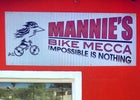 Mannie Heyman’s Windhoek shop
Mannie Heyman’s Windhoek shopTen hours after leaving Namibia’s capital, Windhoek, we went jangling down a spider web of pocked and beaten desert tracks, into what seemed like total isolation. But then our little safari group pulled into a mobile, tented camp on the banks of the desiccated Huab River. There, with a mane of flaxen hair—a wild contrast to his red-and-white shop kit— sat beneath an acacia tree, swigging Windhoek Lagers while he waited for us.
Our tour operator, , told us they’d hired a local bike shop to oversee our stay. But it’s nonetheless surprising when you find a three-time Olympian, a Cape Epic and TransAlp winner, waiting to ride with you.
And the stars kept coming. Our guide for six days was Garth Owen-Smith, author of and grandfather of the conservancy movement in Namibia. This country is one of the bright spots in wildlife conservation, with increasing numbers of free-roaming lion, rhino, and elephant, and the largest population of cheetah in the world. The conservancies are responsible for much of the success. As per an agreement, rural communities receive large tracts of land in exchange for preserving the wildlife—a deal that’s been wildly successful thanks to the economic benefits and the control it gives locals. Owen-Smith and his partner, anthropologist Margaret Jacobson, began working on the idea in the early 1980s, and since then, Namibia has placed 44 percent of its land under localized protection management.
Also along for the ride was , one of the world’s foremost researchers and experts on desert lion. He has collected field studies of the reclusive animal for decades, and with his giant bedraggled beard, his dust-stuffed clothes, and lack of shoes, he looks as though he hasn’t left the bush since he got there.
Over six days, our group of journalists, travel industry leaders, and World Wildlife Fund policy analysts explored the Kunene, the northwestern-most province of Namibia. On the Huab and Huanib rivers, we spotted elephant and rhino in their natural habitat. Giraffe, zebra, and an arc’s worth of antelope—including Namibia’s national animal, the oryx—grazed both far and near as we moved through the environment. Two prides of lion patrolled the shadows during our stay in the Huanib.
We did much of the tracking in Land Rovers, but on several occasions we took Heyman’s fleet of bikes into the bush to search for animals. These rides were highlights of the trip; without the constant clank and growl of the engines, the animals were less inhibited, allowing us a closer look.
One evening, at a spot appropriately named Wereldsend, or World’s End, we spun slowly up a dirt track with herds of oryx and zebra all around us, their hooves thundering so hard on the plain that we could feel it through our bikes.
I’ve been on many safaris, from Togo to Tanzania, Zimbabwe to South Africa, and I was won over by the mountain bike variety on this trip. Not only does it give closer access to the animals, it puts you in the landscape rather than confining you to a vehicle—looking through the window as though you were watching TV. After a day in the saddle, you feel relaxed and healthy, not knotted and creaky from a ride in a jouncing Land Rover.
“Not many people are coming to do the bike safaris yet, but I think that it’s definitely the best way,” says Leander Borg of NatureFriend Safaris, the operator who is teaming up with Heymans for the two-wheeled-bike adventures.
“You see wild lions and rhino from your bicycle. Can you imagine?”
THREE TOP MTB SAFARI OPS can customize trips for anyone from solo travelers to large groups, and because they work with Mannie’s Bike Mecca, the gear is first-rate. I rode an XTR-equipped carbon Merida full-suspension bike that Heymans once raced in the Cape Epic. Normally companies that are not bike-specific do a terrible job with gear and riding for true cyclists, but NatureFriend owner Leander Borg does riding (and is a great rider in his own right) as well as he does hospitality. This might just be the ultimate Bike Safari company out there.
of Cape Town don’t specialize in safaris, but they can tailor any bike trip in South Africa to include not just great riding but also great game viewing. Daytrippers runs set-training camps for those of us in the Northern Hemisphere looking for an exotic, warm-weather riding escape in the winter.
Cape Town-based , run by German-transplant Andreas Lappe, offers hiking, adventure, and cycling itineraries from South Africa all the way up to Uganda—including Madagascar. Having crossed the continent by bicycle himself, Lappe draws upon great knowledge for story-telling during custom cycling tours.


